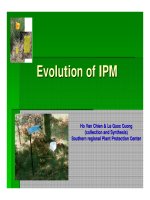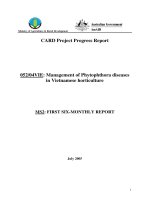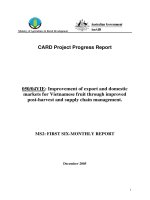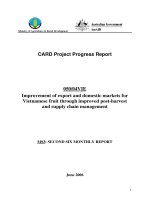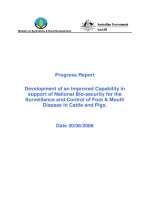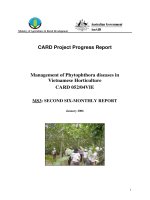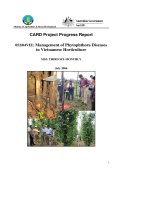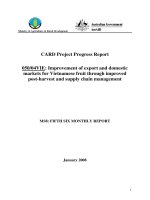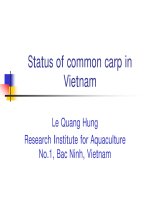Báo cáo nghiên cứu khoa học " Characterization of vaccine candidate strains for E. coli vaccine " ppt
Bạn đang xem bản rút gọn của tài liệu. Xem và tải ngay bản đầy đủ của tài liệu tại đây (281.14 KB, 16 trang )
1
APPENDIX ONE
Characterization of vaccine candidate strains
for
E. coli
vaccine
2
1. Serogroup, fimbriae and enterotoxins possessed by the candidate strains
The virulence characteristics (OK-antigen serogroup, fimbriae and enterotoxins) of the three strains
selected for vaccine production were independently confirmed by The Pig Health and Research Unit
(PHRU), Victorian Department of Primary Industry (Table 1). These strains have been stored as
freeze dried specimens in three separate laboratories (NIVR, UQ and PHRU).
Table 1
:
E. coli
strains used for the preparation of vaccine
Virulence Characteristics
Designation of
E. coli
vaccine strains
O-serogroup Fimbriae Enterotoxin(s)
NVP613
(CARD-VN1)
O8 5F-* STa/STb/LT
NVP1402
(CARD-VN2)
O149: K91 F4 STa/STb/LT
NVP1372
(CARD-VN3)
O64 F5 STa
* Negative for all five recognized fimbriae associated with porcine enterotoxigenic
E. coli
(F4, F5,
F6, F18 and F41). May therefore possess a novel fimbrial antigen.
2. Attempts to produce diagnostic antisera at NIVR to rapidly and specifically
identify the
E. coli
O8 5F- strains (ie strains with NVP613 genotype):
A) Crude whole cell method
Step 1: Preparation of antigen and vaccination of rabbits:
Method:
- Grow isolate (NVP613 5F-) at 37
o
C for 6-8 hours on shaker.
- Inactivate with formalin (0.3% v/v) overnight.
- Plate onto bacteriological agar to confirm inactivation.
- Wash in PBS and centrifuge at 3000 rpm for 5-10 mins (x3).
- Protein determination using the Lowry protein assay (an optic density of 1.0, determined at 280 nm
contained an estimated protein concentration of 1 mg/ml).
- Vaccination schedule: 2 rabbits were injected intravenously at 4-5 day intervals with 0.2; 0.4; 0.6
and 1 mg of antigen, respectively.
- The rabbits were bled 6-7 days after last injection and the serum harvested by centrifugation.
Step 2: Preparation of antigen for cross-absorption:
Note:
E. coli
grown at 18-20
o
C will not produce fimbriae. Therefore, to prepare sera that is specific
for the possible new fimbrial type, the antisera from rabbits is mixed with inactivated NVP613 cells
harvested from an 18-20
o
C culture. Non-specific antigen:antibody complexes are then removed by
centrifugation and the remaining antisera should only agglutinate in the presence of cells expressing
the new fimbrial type. However, it must be remembered that this is an inexpensive but crude
technique and all cross-reactive antibodies may not be removed during cross-absorption.
3
Method:
- Grow isolate (NVP613 5F-) at 18-20
o
C (to prevent production of fimbriae) for 6-8 hours
- Inactivate with formalin (0.3% v/v) overnight
- Wash and centrifuge 3 times in PBS/saline
Absorption:
- Make a 20% cell suspension with the inactivated cells grown at 18-20
o
C in the rabbit antisera
- Incubate 1 hour at 37
o
C, then refrigerate overnight
- High spin to pellet cells
- Remove antisera
- Coagglutinate antisera
- Test against cells grown at 37C
+ Isolate NVP613: +
+ F4:
-
+ F5:
-
+ Field strain (NVP625 5F-): +
Results:
Prepared antisera was tested against the enterotoxigenic
E. coli
strains listed in Table 2 for
agglutination:
Table 2:
Agglutination of
E. coli
strains in polyvalent rabbit sera prepared from a 5F- strain grown at
37
o
C cross-absorbed with cells grown at 18
o
C.
Strains
Growth
temperature of
cultures
O-serotype Virulence factors Agglutination
NVP612 37
o
C O8 5F-/STa/STb/LT +
NVP625 37
o
C O8 5F-/STa/STb/LT +++
NVP1372* 37
o
C O64 F5/STa -
NVP1392 37
o
C O149:K91 F4/STa/STb/LT -
NVP1402* 37
o
C O149:91 F4/STa/STb/LT -
NVP613* 37
o
C O8 5F-/STa/STb/LT +++
20
o
C
+++
NVP1272 37
o
C O8:G7 F4/STa/STb -
- no agglutination observed
+ Weak agglutination (25%)
++ Moderate agglutination (50%)
+++ Strong agglutination (100%)
* vaccine strains
Conclusion:
The agglutination reaction with the vaccine strain prepared at both 37
o
C and 20
o
C
suggests that the antisera prepared from a crude culture extract may not be specific against the
unknown F-antigen only. It might contain other antigenic components present in the O8 strain cell
wall. Therefore, we conclude that in order to prepare diagnostic antisera that is 100% specific, we
will need to purify and identify the unknown 5F- antigen before immunizing rabbits again. Our
4
respective laboratories at NIVR and in Australia neither have the expertise nor the equipment to
prepare purified fimbrial extracts. Following presentation of her work at the 2006 International Pig
Veterinary Society Congress, Prof John Fairbrother (OIE
E. coli
laboratory at the Faculté de
médecine vétérinaire Université de Montréal) invited Dr Do Ngoc Thuy to his laboratory to begin
work on the further characterization of the new fimbrial type.
3. Summary results of experiments in OIE
Escherichia coli
Reference Laboratory, Montreal
for the period from 26/6/2006 to 14/7/2006
A.
Characteristics of 5F- ETEC strains used in the experiments:
Characteristics
Designation
O-serogroup Fimbirae Enterotoxins
NVP612
(CARD-VN1)
O8 5F
-
, F? STa, STb, LT
EC-VN8 O8 5F
-
, F? STa, STb, LT
B.
Results of mannose-resistant haemagglutination:
The two ETEC strains were examined for mannose-resistant haemagglutinating activity using Sheep
Red Blood Cells. Both strains were tested using overnight cultures grown at 18
o
C and 37
o
C. The
density of bacteria in each culture was adjusted to OD=1 (
A
=660
i
m) in NaCl 0.85% using a PYE
Unicam PU-8600 UV/VIS spectrophotometer (Philips), prior to mixing with red blood cells. The
results of haemagglutination of cultures of each strain are presented in Table 1. Mannose-resistant
haemagglutination was observed at 37
o
C, but not at 18
o
C for both strains, confirming the production
of adhesins (ie fimbriae) at 37
o
C.
Table 3
: Haemagglutination results of two 5F- ETEC strains
Cultures grown at:
37
o
C 18
o
C
Strain
NaCl 0.85% 1.5% D-Mannose NaCl 0.85% 1.5% D-Mannose
CARD-
VN1
H (1/1024) H (1/1024) Negative Negative
EC-VN8 H (1/1024) H (1/1024) Negative Negative
C.
Observation of
E. coli
5F- cell morphology by Transmission Electron Microscopy:
Specimen preparation for transmission electron microscopy was carried out as follows:
One drop from the surface of a culture of strain CARD-VN1 grown in nutrient broth at 37
o
C
overnight was placed on a glow discharged (carbon and formvar) coated copper 200 mesh grid, and
allowed to absorb for 2 min. Excess liquid was then removed with filter paper and one drop of 1%
ammonium molybdate (pH=6.5) was added. After 30 sec, the specimen was blotted dry with filter
paper and observed under a Transmission Electron Microscope operated at 80 kV.
Transmission electron microscopy photographs taken at low and high magnification showed the
presence of hair-like structures on the surface of the bacteria cells (an example is shown in Figure 1).
31
Scale bar = 2
t
m
Scale bar = 1
t
m
Scale bar = 200
i
m
5F- ETEC strain (grown
overnight in BHI broth) under
transmission electron
microscopy
6
D. Preliminary results on purification of 5F- fimbriae:
The purification of the 5F- fimbriae was performed using the OIE
E. coli
Laboratory protocol
EcL1000 (Production of Fimbriae) with some modifications. All steps were exactly the same as
described in the protocol, except that:
- In the Precipitation step, the concentration of sulfate ammonium was increased to 30% and 40%
- In the Dialysis step: citric acid 2.5% or sodium desoxycholate were used to precipitate the non-
fimbriae proteins.
After sodium dodecyl sulphate polyacrylamide gel electrophoresis (SDS-PAGE) of the purified
fimbrial extract, the results confirmed that a protein band was present in the gel with a molecular
weight of ~26,000-27,000 kDa. This is the same size as most recognized
E. coli
fimbrial proteins.
However, the protein precipitation and wash steps require further development since the final
fimbrial extract also appeared to still be contaminated with several other proteins.
These were promising results to be followed up by the OIE
E. coli
Reference Laboratory following
Dr Thuy’s return to NIVR.
4. Further characterization of the unknown fimbriae type by the OIE
Escherichia coli
Reference Laboratory, (Report dated September 2008).
Here is a quick update on F19 (Thuy’s new fimbrial type) to let you know what we are doing. As I
already mentioned, we did a new fermentation early in the year and ran the heat-treated extract on
SDS-PAGE. We sent off for N-terminal aa sequencing the 20K band which we had identified by
western using an adsorbed antiserum as the putative fimbrial band (present on the strain grown at
37°C but not at 18°C.). This came back as the following sequence: ATSTVWGGYY. On Blast, this
did not show close similarity with anything, but was not a long enough sequence.
We proceeded to run another gel and send off the band for Mass Spectrometry as this seems to be the
approach of choice now. It came back identified with high confidence factor as OmpX (see attached),
with predicted molecular mass of 17kDa. I was not too convinced that this is our adhesin as it is an
Omp and not a fimbriae, and our band showed up at 20kDa on western. I have read some articles on
OmpX- it could be involved in adherence to and invasion of cells in culture and is related to Ail in
Yersinia
, and pagC in
Salmonella
. As I am not fully convinced, we will run another SDS-PAGE and
this time, we will cut out any bands we observe around 18 to 22 kDa that seem to be less expressed
at 18°C, and send them off for MS. It costs around $60 per reaction. We are doing this at the
moment.
As the DNA sequence of the gene in
Enterobacter
is known, we could also test by PCR or probe (see
pdf attached) phenotypically positive and negative isolates to see if there is any correlation.
I have tested all of the 140 isolates in our collection from Thuy by immunofluorescence using the
adsorbed anti-F19 serum. There is a good correlation with the virotype Paa,STa,STb,LT,East1. All of
the isolates have been virotyped for 20 virulence genes. Also, the postweaning isolates (about 40)
have been tested by MIC, for the paper with Thuy. We did not do the preweaning isolates for MIC,
as you had said that these isolates had already been tested and will be in another paper. Several of the
PWD isolates are enroflox resistant, hence my interest to test for the qnr genes. I am compiling all
these results at the moment.
I know that the F19 characterisation has been taking a lot of time to get results. It is a question of
man power. When my technician has had spare time, she has worked on it. However, she went off on
pregnancy leave! Now that the summer holidays are finished, I have put another technician on the
project. We will run more gels this week or next and send off bands for MS. Our problem has always
been that the adhesin band is not produced in great quantities as we observed with F4, F165 etc, so it
is not easy to identify the correct band.
7
Do you think that at this point you will have enough for AUSAID? I think that if
we want to go further, it would be a great project for a student. Another approach if
we still have problems could be DIGE, the proteomic approach. We could send the
18C and 37C preps off for 2-D gel electrophoresis and MS.
Let me know what you think
John
PS How is Matthew progressing?
PPS Is Thuy still in Vietnam? We have to advance the PWD paper once I compile
the data.
John M. Fairbrother, BVSc, PhD
Director / Directeur
Reference Laboratory
for
Escherichia coli
john.morris.fairbrother
@umontreal.ca
T 450.773.8521 or
514.345.8521, ext. 18234
F 450.778.8108
Cell 450.230.2720
GREMIP, Faculté de
médecine vétérinaire
Université de Montréal
3200 Sicotte, C.P. 5000
Saint-Hyacinthe (Quebec)
Canada J2S 7C6
1
APPENDIX TWO
Vaccine production protocol
1.
An inactivated whole cell multivalent vaccine was prepared according to the protocol of the
Bacteriology Laboratory, NIVR. The vaccine contained three
E. coli
strains with the O-antigen and
virulence characteristics of each listed in Table 1.
Table 1
:
E. coli
strains used for the preparation of vaccine
Characteristics
Designation of
E. coli
vaccine strains
O-serogroup Fimbriae Enterotoxin(s)
CARD-VN1 O8 F? STa/STb/LT
CARD-VN2 O149: K91 F4 STa/STb/LT
CARD-VN3 O64 F5 STa
2.
Specialised culture media were prepared in order to provide favourable growth conditions for the
production of fimbriae. For efficient expression of F4, strain CARD-VN2 was grown on Buffered
Glucose Nutrient Agar as described by Jones & Rutter (1972), whereas for the production of F5
fimbriae on strain CARD-VN3, Minca agar as described by Guinee
et al.
(1977a) was used. For the
strain with currently uncharacterized fimbriae (CARD-VN-1), it was shown in Appendix One that
Buffered Glucose Nutrient Agar was suitable for the production of a possible new fimbrial type.
The procedure used to prepare the vaccine is summarised in Figure 1. In brief, cultures of each strain
were revived from freeze-dried tubes, inoculated into TSB and incubated at 37
o
C overnight with
agitation (150 rpm). The broth cultures were flood seeded onto Buffered Glucose Nutrient Agar or
Minca Agar, incubated at 37
o
C for 18 h and harvested in PBS to an optical density equivalent to
approximately 10
10
cells/ml by viable count of diluted samples on SBA plates. The purity and
identity of each bacterial suspension were assessed by streaking a loopful onto SBA incubated
aerobically and anaerobically, as well as Sabouraud Dextrose Agar containing chloramphenicol. The
suspensions were mixed with buffered formaldehyde (10%) (v/v) to a final concentration of 0.3%
(v/v) and incubated at 37
o
C for 24 h with shaking. Sterility testing was performed by placing 0.5 ml
of the killed vaccine into 25 ml of enrichment broth, incubated at 37
o
C for 24 h and subcultured onto
SBA (aerobic and anaerobic incubation), MCA and SC. All plates were kept at 37
o
C for up to 10
days. The vaccine preparation was considered sterile when there was no evidence of bacterial or
fungal growth. Once the results of sterility testing were known, equal volumes of each of the five
cultures were blended together with sterile 2% (v/v) aluminum hydroxide (Alhydrogel) (Brenntag,
Denmark) to a final concentration of 20%. The vaccine was dispensed into sterile bottles in 10 ml
aliquots. A final sterility check was performed on the leftover vaccine (Figure 2).
2
Figure 1:
Preparation of
E. coli
multivalent vaccine (1 ml of vaccine contains approximately 10
10
bacteria)
10% (v/v) bufferred
formaldehyde to a final
concentration of 0.3%
Mix with equal colume of
each bacterin
Add 2% (v/v) aluminum
hydroxide to a final
concentration of 20%
Freeze-dried
cultures
2 ml TSB (37
o
C,
overnight)
SBA (37
o
C,
overnight)
Appropriate culture
media (37
o
C,
overnight)
20 ml TSB (37
o
C,
overnight)
Purity testing
PBS (10
1
0
bacteria/ml)
Sterility testing
Sterility testing
Dispense into sterile
bottles and label
3
Figure 2:
NIVR
E. coli
vaccine
References:
Jones, G. W. & Rutter, J. M. (1972).
Role of the K88 antigen in the
pathogenesis of neonatal diarrhoea caused by
Escherichia coli
in piglets.
Infection
and Immunity
6
, 918-927.
Guinee, P. A. M., Veltkamp, J. & Jansen, W. H. (1977a).
Improved Minca
medium for the detection of K99 antigen in calf enterotoxigenic strains of
Escherichia coli
.
Infection and Immunity
1
APPENDIX THREE
Results of safety and efficacy studies conducted on NIVR’s
E. coli
vaccine in
comparison to commercially available vaccines (Pfizer Litterguard and
Intervet EcoVac)
1. Protection studies
During Dr Do Ngoc Thuy’s PhD studies, the NIVR vaccine, which initially encorporated five
strains was tested for the ability to protect newborn piglets from challenge infection.
Table 1:
ETEC strains used for vaccine preparation and for challenge
Characteristics
Designation of ETEC
strains
O-serogroup Fimbriae Enterotoxin(s)
NVP613 O8 5F
-
STa/STb/LT
NVP1402 O149:K91 F4 STa/STb/LT
NVP1271* O8:G7 F4 STa/STb
NVP2081* O101 F4 STa/STb
NVP1372 O64 F5 STa
* These strains were not included in the final NIVR vaccine as protection against these strains is
provided by the F4 CARD-VN2 strain.
Twelve pregnant gilts (crossbred Landrace x Mong Cai x Yorkshire) were obtained from a local
commercial piggery and maintained on an experimental farm belonging to the National Institute
of Veterinary Research (NIVR), Hanoi, Vietnam. During pregnancy, ten gilts were vaccinated
subcutaneously (SC) in the neck twice with 5 ml of the inactivated multivalent whole cell vaccine
at 6 weeks and then again at 2 weeks before parturition. The two remaining gilts, which acted as
non-immunised controls, received subcutaneous injections of PBS at the same time. During late
pregnancy, the gilts were separated into isolated farrowing rooms (two vaccinated gilts or one
unvaccinated gilt per room).
Each inoculum used for challenge administration was prepared from cultures grown overnight on
SBA plates. After incubation at 37
o
C, the growth was harvested into sterile PBS and the
suspension was adjusted to a density of approximately 10
10
bacteria/ml.
Following birth, piglets were allowed access to colostrum and nursed a further 24 h, after which
they were intragastrically inoculated with 1 ml of bacterial suspension (10
10
bacteria/ml) via a
stomach tube.
Piglets born to both vaccinated gilts and non-vaccinated gilts were challenged with a homologous
bacterial suspension prepared from one of the five vaccine strains (one strain per two litters). In
each litter, five piglets were challenged with a single
E. coli
strain and the remaining piglets were
left as non-inoculated in-contact control piglets. Only two strains (NVP613 and NVP1402) were
used to challenge the piglets from the control gilts.
None of the vaccinated or control gilts showed abnormal clinical signs in the 24 h period
immediately following vaccination or administration of the placebo. From each gilt, 10-12 piglets
were born alive. All piglets were healthy and had an average weight of 0.9-1.2 kg/piglet.
2
Table 2:
Designation of groups of piglets used for challenge
No. of piglets
Gilt
Group (litter
number)
Challenge In-contact
Strain
challenged
1 (I, II) 10 11 NVP613
2 (III, IV) 10 12 NVP1402
3 (V, VI) 10 12 NVP1271
4 (VII, VIII) 10 11 NVP2081
Vaccinated gilts
5 (IX, X) 10 13 NVP1372
6 (XI) 5 6 NVP613
Unvaccinated
gilts
7 (XII) 5 7 NVP1402
Results of the protection studies are shown in Tables 3-5. Vaccinated pigs had less diarrhoea,
showed reduced faecal shedding of the challenge strain and fewer pigs became moribund and
required euthanasia. These results confirm that the vaccine does protect from significant
homologous challenge infection.
Table 3:
Frequency of diarrhoea and excretion of challenge strain in piglets born from vaccinated
gilts and unvaccinated controls
No. of piglets with
diarrhoea (%)
No. of piglets
excreting the challenge
strain (%)
Gilt
Group (litter
number)
Strain
challenged
Challenge In-contact
Challenge In-contact
1 (I, II) NVP613
3/10
a
(30.0)
1/11
b
(9.1)
4/10
a
(40.0)
3/11
b
(27.3)
2 (III, IV) NVP1402
3/10
a
(30.0)
1/12
b
(8.3)
6/10
(60.0)
3/12
b
(25.0)
3 (V, VI) NVP1271
3/10
a
(30.0)
1/12
b
(8.3)
4/10
a
(40.0)
2/12
c
(16.7)
4 (VII, VIII) NVP2081
2/10
b
(20.0)
0/11
b
(0.0)
3/10
a
(30.0)
2/11
b
(18.2)
Vaccinated
gilts
5 (IX, X) NVP1372
3/10
a
(30.0)
1/13
b
(7.7)
5/10
(50.0)
4/13
b
(30.8)
6 (XI) NVP613
5/5
(100.0)
5/6
(83.3)
5/5
(100.0)
6/6
(100.0)
Unvaccinated
gilts
7 (XII) NVP 1402
5/5
(100.0)
5/7
(71.4)
5/5
(100.0)
7/7
(100.0)
3
a:
P<0.05 (vaccinated groups vs. control group)
b:
P<0.01 (vaccinated groups vs. control group)
c:
P< 0.001 (vaccinated groups vs. control group) (two-tailed Fisher’s exact test)
Table 4:
Duration of diarrhoea and excretion of challenge strains in piglets born from vaccinated
ilts and unvaccinated controls
Diarrhoea
(average days)
Excretion of
challenge strain
(average days)
Gilt
Group (litter
number)
Strain
challenged
Challenge In-contact Challenge In-contact
1 (I, II) NVP613 2.0
a
1 2.5
a
1.3
2 (III, IV) NVP1402 2.0
a
1 2.3
a
1.7
3 (V, VI) NVP1271 1.7 1 1.8 2.0
4 (VII, VIII) NVP2081 1.5 - 2.0 1.5
Vaccinated
gilts
5 (IX, X) NVP1372 1.7 1 2.0 1.8
6 (XI) NVP613 3.5
b
1.8 5.5
b
2.5
Unvaccinated
gilts
7 (XII) NVP1402
4
c
1.4
6
c
2.2
a:
Average number excluded the two piglets submitted for necropsy at 24 h p.i.
b:
Average number excluded the three piglets euthanased at 16-24 h p.i. and submitted for necropsy
c:
Average number excluded the four piglets euthanased at 16-25 h p.i. and submitted for necropsy -
: None piglet in the group had diarrhoea
Table 5:
Morbidity requiring euthanasia in piglets born from vaccinated gilts and unvaccinated
controls
Gilts
Group
(Litter
number
Strain
challenged
No. of piglets
euthanased/inoculated
(%)
No. of piglets
euthanased /in-contact
(%)
1 (I, II) NVP613 0/10 (0)
a
0/11 (0)
2 (III, IV) NVP1402 0/10 (0)
a
0/12 (0)
3 (V, VI) NVP1271 0/10 (0)
a
0/12 (0)
4 (VII, VIII) NVP2081 0/10 (0)
a
0/11 (0)
Vaccinated
gilts
5 (IX, X) NVP1372 0/10 (0)
a
0/13 (0)
6 (XI) NVP613 3/5 (60.0) 2/6 (33.3)
Unvaccinated
gilts
7 (XII) NVP1402 4/5 (80.0) 1/7 (14.3)
a
: P<0.05 (vaccinated groups vs. control group) (two-tailed Fisher’s exact test)
4
2. Vaccine safety study:
Sixteen healthy pregnant sows were allocated into two groups:
* Group 1: 8 sows, vaccinated with Pfizer Litterguard vaccine
* Group 2: 8 sows, vaccinated with NIVR's vaccine
Each sow were vaccinated subcutaneously twice with 2 ml of vaccine at 9 weeks and
again at 12 weeks of gestation. The following criteria were recorded for each farrowing sow:
+ Piglets born alive
+ Stillbirths
+ Mummies or (died before parturition)
+ Deformities eg splay legs
+ Abortion
Differences in each of the above criteria for each group of sows were assessed by using
the Student's t-test (two-tailed). All statistical significance was set at a P (two-sided) value of
< 0.05, using the statistical program GraphPad Instat version 3.01.
A summary of the results is shown in Table 2.
Table 2:
Recorded criteria on safety stud
Recorded criteria Group 1 (8 sows) Group 2 (8 sows)
Piglets born alive 80 82
Stillbirths 3 4
Mummies or (died before parturition) 2 2
Deformities eg splay legs 4 5
Abortion 0 0
There were no significant differences between two groups of sows (all P values >0.05).
3. Efficacy study:
For the efficacy study, 4 groups of pigs (12 weeks of age) were divided as follows:
Control group n = 5 pigs
Litterguard group n = 10 pigs
Intervet vaccine n = 10 pigs
NIVR vaccine n = 10 pigs
The procedure for bleeding and vaccination as follows:
Age of pigs (weeks)
12 Bleeding and 1
st
vaccination
16 2
nd
vaccination
18 Bleeding
All pigs showed excellent health during and after the experiment, except that 1 pig from the
control group developed shock and died after the first bleeding. A total of 34 sera samples were
examined for antibody level against F4 antigens by ELISA test (according to the protocol from
E.
coli
Lab, DPI. Bendigo, Victoria, Australia).
5
Table 4:
Statistical analysis raw data
Group
Pre vaccination
antibod
y
levels
Post vaccination
antibod
y
levels
Post-pre
diff
litter
g
uard 1.337 1.772 0.435
litter
g
uard 1.136 2.013 0.877
litterguard 1.214 1.944 0.73
litterguard 1.215 2.005 0.79
litter
g
uard 1.004 1.965 0.961
litterguard 0.648 1.538 0.89
litter
g
uard 0.981 1.842 0.861
litterguard 1.176 1.843 0.667
litter
g
uard 1.376 2.182 0.806
litterguard 0.914 2.026 1.112
ecovac 1.11 2.162 1.052
ecovac 1.164 2.173 1.009
ecovac 1.954 2.252 0.298
ecovac 0.906 2.088 1.182
ecovac 0.76 2.299 1.539
ecovac 0.432 1.961 1.529
ecovac 0.83 1.701 0.871
ecovac 1.062 1.826 0.764
ecovac 1.236 1.699 0.463
ecovac 0.944 1.643 0.699
NIVR 0.562 1.871 1.309
NIVR 1.192 1.715 0.523
NIVR 1.071 2.122 1.051
NIVR 1.124 1.943 0.819
NIVR 0.34 1.599 1.259
NIVR 1.028 1.893 0.865
NIVR 1.135 1.798 0.663
NIVR 1.41 2.023 0.613
NIVR 1.014 2.048 1.034
NIVR 1.121 1.68 0.559
control 1.447 1.664 0.217
control 0.8 0.91 0.11
control 0.593 0.729 0.136
control 0.611 1.052 0.441
6
Table 5:
Summary statistics
Pre- vaccination mean OD values
Group Mean Variance
Control 0.863 0.1605
Litter
g
uard 1.100 0.0475
EcoVac 1.040 0.1571
NIVR 1.000 0.0985
Post- vaccination mean OD values
Group Mean Variance
Control 1.089 0.1654
Litter
g
uard 1.913 0.0309
EcoVac 1.980 0.0614
NIVR 1.869 0.0292
Pre-Post vaccination mean OD values
Group Mean Variance
Control 0.2260 0.0226
Litter
g
uard 0.8129 0.0328
EcoVac 0.9406 0.1683
NIVR 0.8695 0.0814
Statistical analysis
An analysis of the difference between the Pre and post vaccination OD values was done using
linear regression with pairwise differences. Statistical Analysis was preformed by Genstat 8
th
Edt, Laws Agricultural Trust, Rothamsted Experimental Station.
Results
There was a significant difference between the OD levels for the treatment groups (p<0.003).
There was no significant difference between the antibody response elicited (as demonstrated by
OD values) by Litterguard, EcoVac or NIVR vaccines (p>0.1). All three vaccines were
significantly different from the control group (p< 0.005) (Table 1)
Table 1
Treatment group Mean
Control 0.2260
a
Litter
g
uard 0.8129
b
EcoVac 0.9406
b
NIVR 0.8695
b
* Means with different subscripts differ significantly p<0.005
